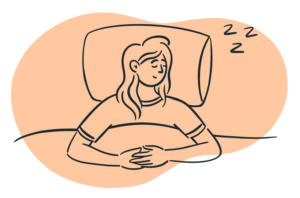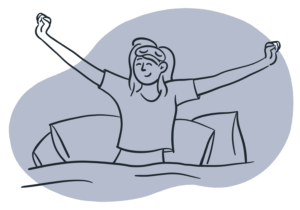Daylight Saving Time
Disclosure: By clicking on the product links in this article, Mattress Nerd may receive a commission fee at no cost to you, the reader. Read full disclosure statement.
Daylight saving time begins Sunday, March 13 and runs through Sunday, Nov. 14. That means, before going to bed Saturday, March 12, you’ll need to turn your clocks up an hour if they don’t automatically reflect that change.
(Oh, and fun fact: It’s actually daylight saving time and not daylight savings time.)
Regardless of your feelings about whether we need to get rid of the time change or not, chances are you’re stuck with dealing with it. (Unless you’re in Arizona or Hawaii, where daylight saving time isn’t observed.) And if you’re forced to “spring forward,” then your sleep will likely suffer for a few days while you get adjusted … until November when you “fall back” to standard time and have to adjust again.
(Another fun fact: When you switch to daylight saving time, you’ll need to switch your time abbreviations. For example, “9 p.m. CST” should become “9 p.m. CDT.” But that’s another story.)
Switching back and forth between daylight saving and standard time can wreak havoc on sleep, leaving you wide-eyed at bedtime in the spring and craving sleep well before bedtime in the fall. And that hope for an “extra hour of sleep” you get when clocks fall back? Don’t count on it. Because chances are you’ll wake before you can take advantage of it.
The time change’s impact on sleep can be a problem. When we don’t get enough sleep, we are at greater risk for all sorts of mental and physical health problems including obesity, diabetes, cardiovascular disease, and early death. We are also more prone to depression, anxiety, and irritability, as well as accidents, such as car crashes and falls, according to the National Heart, Lung, and Blood Institute.
The time change can be so disruptive to sleep that the American Academy of Sleep Medicine (AASM) released a position statement in 2020 calling for the elimination of seasonal time changes and adopting permanent standard time for improved health and safety.
“Daylight saving time increases our morning exposure to darkness and evening exposure to sunlight, the most powerful timing cue for the human body clock,” said Dr. Shannon Sullivan, chair of the AASM Public Safety Committee and clinical professor of sleep medicine at Stanford University School of Medicine in the position statement. “The time change causes misalignment between the body’s daily rhythm and the clock, making it harder to fall asleep at night, disrupting sleep quality, and leading to sleep loss which can negatively impact health and safety.”
Daylight Saving and Circadian Rhythm
That’s right. Entering or exiting daylight saving time can do a number on our circadian rhythm — our body’s internal 24-hour clock. It tells us when to sleep, when to wake up, when to eat, and so on. This master clock is operated by a group of neurons in the brain which takes cues our body sends when it senses changes in the environment. For example, when the sun sets and it gets dark outside, sensors in our eyes send a message to the brain which triggers the production of melatonin, the body’s natural sleep hormone.
For most people, this process works like, well, clockwork. But when our schedules get disrupted by even just an hour, like when daylight saving time begins or ends, it confuses the circadian rhythm. When that happens, we have difficulty falling asleep at bedtime or staying awake until bedtime comes. According to a review in the journal Sleep Medicine Reviews a mere one-hour shift in sleep cycle can affect sleep for up to a week.
This can be especially challenging for children, who tend to sleep better when they are put on a regular sleep-wake schedule. Kids are more confident and secure when their day and night routines are predictable and familiar, says Head Start Early Childhood Learning & Knowledge Center. When that schedule gets out of sync, they can become sleepy or sleepless, which can trigger moodiness and the ever-dreaded temper tantrum.
Coincidentally, studies have found that cluster headaches tend to increase when the seasons change, particularly around the time we adjust our clocks for daylight saving time. Researchers suggest this may be due to sleep schedules falling out of sync.
So, what’s more difficult to recover from — springing forward or falling back? Let’s take a closer look.
Springing Forward and Sleep
On the first few nights that daylight saving time begins in the spring, we may find ourselves lying in bed unable to fall asleep. That’s because, despite what the clock says, we’re going to bed an hour earlier than usual. When we wake, we’ve essentially lost an hour of sleep. That sleep deprivation can have repercussions.
According to a study in the Journal of Applied Psychology, on the Mondays directly following the switch to daylight saving time, workers sleep an average of 40 minutes less than on other days. They also sustain more workplace injuries and injuries of greater severity. However, the same was not seen when workers shifted from daylight saving time to standard time.
Another study published in the American Journal of Cardiology, showed that there was a slight increase in heart attacks during the first Sunday of daylight saving time. The same trend was seen in a New England Journal of Medicine study, which also found a small decrease in heart attacks when daylight saving time ended.
But that doesn’t mean falling back is any easier.
Falling Back and Sleep
Many people say they prefer the transition from daylight saving to standard daylight time because they “gain” an extra hour of sleep. It’s true that in the days following shifting back to standard time incidents of heart attacks and traffic accidents fall below normal levels. However, during that first week back to standard time, many people still wake up earlier, have trouble falling asleep, and are more likely to wake up during the night, according to Harvard researchers.
Those most vulnerable to sleep problems with this time shift include those who generally sleep less than 7.5 hours at night, early risers, and overnight or late-night shift workers. Another group that may be especially impacted by the ending of daylight saving time are people who suffer from seasonal affective disorder (SAD), a form of depression that occurs at the same time each year, most often in climates where there is less sunlight at certain times of the year.
Daylight Saving Sleep Tips
There are some clever strategies health officials recommend to ease the transition into and out of daylight saving time and help adults get their recommended 7 hours of sleep or 8-10 for children. Here’s a few of those tips:
- Practice good sleep hygiene by ensuring your sleeping environment is conducive to sleep. Use black-out shades to block out outside light and sound machines to mask outside noises. Invest in a comfortable mattress and bedding. And set the thermostat a few degrees cooler at night than what it’s set at during the day.
- Gradually adjust sleep and wake times 15 to 20 minutes for a few nights until the time change goes into effect.
- Adjust daily routines accordingly, such as meal times or workout schedules.
- Get outdoors and absorb plenty of sunshine during the day. Natural daylight can help alleviate tiredness and boosts mood. It also suppresses the production of melatonin.
- Take a short nap. If you’re feeling worn down, take a break for some shut-eye. But try not to sleep for more than 20 minutes as doing so can leave you feeling groggy.
- Watch your caffeine intake. Caffeine can stay in your system for up to six hours. So, avoid caffeine-loaded coffee, sodas and other foods and beverages during the second half of your day.
Final Thoughts
Adjusting to daylight saving time or back to standard time may not sound like a hassle. But studies show it can wreak havoc on sleep for up to a week or more. A week’s worth of sleep deprivation can do a number on your physical and mental health, and put you at risk for accidents and poor decisions. In fact, the impact of daylight saving time shifts on sleep are concerning enough that the AASM, an organization founded on advancing sleep care and enhancing sleep health to improve lives, has taken a bold stance in urging the elimination of seasonal time changes in favor of adopting a permanent standard time.
Most of us can’t avoid the time change. So, until it’s eliminated, the best you can do is to prioritize your own sleep during these shifts in time, and take steps to ensure a better night’s sleep.

